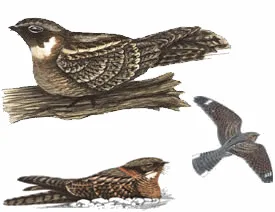
Red-necked Nightjar
[order] CAPRIMULGIFORMES | [family] Caprimulgidae | [latin] Caprimulgus ruficollis | [UK] Red-necked Nightjar | [FR] Engoulevent a col roux | [DE] Rothals-Ziegenmelker | [ES] Chotacabras pardo | [NL] Moorse Nachtzwaluw
Subspecies
| Genus | Species | subspecies | Breeding Range | Breeding Range 2 | Non Breeding Range |
| Caprimulgus | ruficollis | EU, AF | Iberian Peninsula to nw AF | w AF | |
| Caprimulgus | ruficollis | desertorum | ne Morocco, n Algeria and n Tunisia | to west Africa | |
| Caprimulgus | ruficollis | ruficollis | Iberian Pen., n Morocco | to west Africa |
Physical charateristics
Largest nightjar in west Palearctic with more robust structure than Nightjar and paler, buff-grey, more variegated plumage. In close view, large white throat, rufous half-collar on nape, bold white spots on outer tail-feathers, and smaller white spots on outer primaries may all show on both sexes.
Listen to the sound of Red-necked Nightjar
[audio:http://www.aviflevoland.nl/sounddb/R/Red-necked Nightjar.mp3]
Copyright remark: Most sounds derived from xeno-canto
| wingspan min.: | 65 | cm | wingspan max.: | 69 | cm |
| size min.: | 30 | cm | size max.: | 32 | cm |
| incubation min.: | 17 | days | incubation max.: | 18 | days |
| fledging min.: | 18 | days | fledging max.: | 18 | days |
| broods: | 2 | eggs min.: | 1 | ||
| eggs max.: | 3 |
Range
Eurasia, Africa : Iberian Peninsula to Northwest AF
Habitat
Breeds in lower middle latitudes, in dry warm Mediterranean and oceanic climates, mainly in lowlands below 800-1000 m. Basic requirements include patches of bare or sandy soil, scattered ground cover, and some bushes or trees for song-posts. In parts of range, resorts to closed stands of trees, including woods of stone pines on moist ground.
Reproduction
Breeds form early march to july, second brood are common well in to august. Eggs (usually 2, sometimes 1, rarely 3) were laid directly on the bare ground or on a leaf litter. In most cases the nest site was located under a tree consisting of a shallow scrape. incubation period of circa 17 days (range = 16-19 days). Most of the chicks fledged at 18 to 20 days. When distured at the nest by humans or predators or for example thermal stress, the species move their nests. Mostly witin a small distance from the orginal and during incubation or when the young are ready to fledge.
The pairs moving nests were of long pair bonding and mostly experienced breeders.
The pairs moving nests were of long pair bonding and mostly experienced breeders.
Feeding habits
Primarily Insects. Prey taken mainly in silent floating and wheeling flight with at times bouts of fluttering, also sudden erratic twists and turns. Such foraging activity mainlycrepuscular (dusk and dawn) and nocturnal (at night). Less commonly forages on ground, feeding on young locusts and beetles.
Conservation
This species has an extremely large range, and hence does not approach the thresholds for Vulnerable under the range size criterion (Extent of Occurrence <20,000 km2 combined with a declining or fluctuating range size, habitat extent/quality, or population size and a small number of locations or severe fragmentation). Despite the fact that the population trend appears to be decreasing, the decline is not believed to be sufficiently rapid to approach the thresholds for Vulnerable under the population trend criterion (>30% decline over ten years or three generations). The population size is very large, and hence does not approach the thresholds for Vulnerable under the population size criterion (<10,000 mature individuals with a continuing decline estimated to be >10% in ten years or three generations, or with a specified population structure). For these reasons the species is evaluated as Least Concern.
Caprimulgus ruficollis is a summer visitor to Iberia, with Europe accounting for less
than half of its global breeding range. Its European breeding population is relatively
small (<110,000 pairs), but was stable between 1970-1990. Although the trend of the stronghold population in Spain during 1990-2000 was unknown, the species remained stable in Portugal.
Caprimulgus ruficollis is a summer visitor to Iberia, with Europe accounting for less
than half of its global breeding range. Its European breeding population is relatively
small (<110,000 pairs), but was stable between 1970-1990. Although the trend of the stronghold population in Spain during 1990-2000 was unknown, the species remained stable in Portugal.

Migration
Migratory. Winter quarters lie in West Africa, though not yet delineated, and few passage observations south of breeding range.
Movements evidently broad-front. Reported mid-March to early May in Western Sahara, across Morocco and in western Algeria, arriving Tunisia and Spain in late April. Most have left Iberia by late October, though stragglers occur in November; regularly on passage on Gibraltar. Rare records from Mauritania also coastal. Scarce visitor to Niger inundation zone (Mali), with various records spanning October-March. No records Chad or Nigeria, but singles obtained northern Ghana in March and northern Ivory Coast in January.
Movements evidently broad-front. Reported mid-March to early May in Western Sahara, across Morocco and in western Algeria, arriving Tunisia and Spain in late April. Most have left Iberia by late October, though stragglers occur in November; regularly on passage on Gibraltar. Rare records from Mauritania also coastal. Scarce visitor to Niger inundation zone (Mali), with various records spanning October-March. No records Chad or Nigeria, but singles obtained northern Ghana in March and northern Ivory Coast in January.
Distribution map

